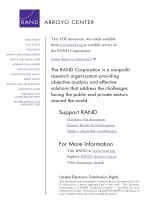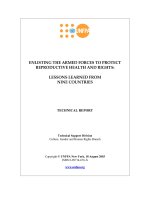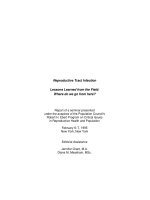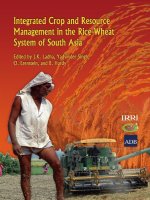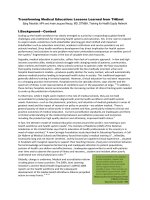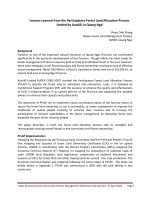Urban Battle Fields of South Asia - Lessons Learned from Sri Lanka, India, and Pakistan pptx
Bạn đang xem bản rút gọn của tài liệu. Xem và tải ngay bản đầy đủ của tài liệu tại đây (2.9 MB, 174 trang )
This PDF document was made available
from
www.rand.org as a public service of
the RAND Corporation.
6
Jump down to document
Visit RAND at www.rand.org
Explore RAND Arroyo Center
View document details
This document and trademark(s) contained herein are protected by law
as indicated in a notice appearing later in this work. This electronic
representation of RAND intellectual property is provided for non-
commercial use only. Permission is required from RAND to reproduce, or
reuse in another form, any of our research documents.
Limited Electronic Distribution Rights
For More Information
CHILD POLICY
CIVIL JUSTICE
EDUCATIO
N
ENERGY AND ENVIRONMENT
HEALTH AND HEALTH CAR
E
INTERNATIONAL AFFAIR
S
NATIONAL SECURIT
Y
POPULATION AND AGIN
G
PUBLIC SAFETY
SCIENCE AND TECHNOLOGY
SUBSTANCE ABUSE
TERRORISM AND
HOMELAND SECURITY
TRANSPORTATION AND
INFRASTRUCTURE
The RAND Corporation is a nonprofit
research organization providing
objective analysis and effective
solutions that address the challenges
facing the public and private sectors
around the world.
Purchase this document
Browse Books & Publications
Make a charitable contribution
Support RAND
This product is part of the RAND Corporation monograph series.
RAND monographs present major research findings that address the
challenges facing the public and private sectors. All RAND mono
-
graphs undergo rigorous peer review to ensure high standards for
research quality and objectivity.
C. Christine Fair
Prepared for the United States Army
Approved for public release; distribution unlimited
Urban Battle Fields
of South Asia
Lessons Learned from Sri Lanka,
India, and Pakistan
The RAND Corporation is a nonprofit research organization providing
objective analysis and effective solutions that address the challenges
facing the public and private sectors around the world. RAND’s
publications do not necessarily reflect the opinions of its research clients
and sponsors.
R
®
is a registered trademark.
© Copyright 2004 RAND Corporation
All rights reserved. No part of this book may be reproduced in any
form by any electronic or mechanical means (including photocopying,
recording, or information storage and retrieval) without permission in
writing from RAND.
Published 2004 by the RAND Corporation
1776 Main Street, P.O. Box 2138, Santa Monica, CA 90407-2138
1200 South Hayes Street, Arlington, VA 22202-5050
201 North Craig Street, Suite 202, Pittsburgh, PA 15213-1516
RAND URL: />To order RAND documents or to obtain additional information, contact
Distribution Services: Telephone: (310) 451-7002;
Fax: (310) 451-6915; Email:
Library of Congress Cataloging-in-Publication Data
Fair, C. Christine.
Urban battle fields of South Asia : lessons learned from Sri Lanka, India, and
Pakistan / C. Christine Fair.
p. cm.
“MG-210.”
Includes bibliographical references.
ISBN 0-8330-3682-3 (pbk.)
1. Urban warfare—Sri Lanka. 2. Urban warfare—India. 3. Urban warfare—Pakistan.
4. Terrorism—Sri Lanka—Prevention. 5. Terrorism—India—Prevention. 6.
Terrorism—Pakistan—Prevention. 7. War on Terrorism, 2001– I. Title.
U167.5.S7F35 2004
355.4'26'0954—dc22
2004019129
The research described in this report was sponsored by the United States
Army under Contract No. DASW01-01-C-0003.
iii
Preface
Over the past several years, the U.S. military has become increasingly
interested in military operations in urban areas. This attention is war-
ranted because such operations are among the most complex chal-
lenges that confront the U.S. Army, be it a conventional conflict or
military operations other than war. Recent Army experiences in Iraq
demonstrate the ability of the adversary to engage U.S. forces in ur-
banized areas to vitiate much of the U.S. military’s edge in high-
technology firepower. The likelihood that U.S. forces will engage in
these environments will only increase as societies continue to urban-
ize.
Compared to a number of other nations, the Army has relatively
less experience operating in this environment. There are countries
that have been immersed in urban internal security and peace opera-
tions for decades. This report will look at three such states: Sri Lanka,
India, and Pakistan. While the three countries lack the technological
sophistication and resources of U.S. armed forces, their experiences
may be illuminating because of their extensive encounters with such
conflicts. Moreover, they have had to find means of countering the
urban threat within severe budget constraints.
This monograph will analyze cases involving sustained cam-
paigns of urban terrorism that have occurred in Sri Lanka, India, and
Pakistan. It will identify key innovations of the organizations using
terrorism. It will also detail the three states’ responses to the evolving
threats they confront, noting successful as well as unsuccessful efforts.
This effort will specifically focus upon the operational and tactical as-
iv Urban Battle Fields of South Asia
pects of the selected campaigns. It will not address the political, eco-
nomic and sociological dimensions of these cases, which have been
amply addressed by the literature on these conflicts.
This monograph has several purposes. First, it seeks to garner
operational insights from the experiences of countries that may en-
hance the Army’s ability to operate in the urban environment. Sec-
ond, it identifies common structural similarities within the militant
organizations in question that might be targeted to degrade their
ability to project power. Third, as these states are all partners to vari-
ous extents in the global war on terrorism, this report describes ways
to improve security cooperation programs with these states. Finally, it
lists key insights from these countries that may inform U.S. stability
operations in Afghanistan, Iraq, and future operations.
This research is a part of a larger effort led by RAND Arroyo
Center to identify current U.S. force requirements for urban contin-
gency planning and to develop innovative approaches for doing so.
This monograph will be of interest to individuals within the govern-
ment whose responsibilities include doctrine, policy designs, plan-
ning, and preparation to support civil or military operation in urban
environments. It will also be of interest to individuals interested in
structural features of organizations using terrorism to achieve their
objectives.
Research in conjunction with this report was undertaken for the
U.S. Army Training and Doctrine Command (TRADOC) and was
conducted in RAND Arroyo Center’s Force Development and Tech-
nology Program. RAND Arroyo Center, part of the RAND Corpora-
tion, is a federally funded research and development center sponsored
by the United States Army.
For more information on RAND Arroyo Center, contact the
Director of Operations (telephone 310-393-0411, extension 6419;
FAX 310-451-6952; e-mail ), or visit Ar-
royo’s web site at />v
Contents
Preface iii
Contents
v
Figures
ix
Tables
xi
Summary
xiii
Acknowledgments
xvii
Glossary
xix
CHAPTER ONE
Introduction 1
Background
1
Methodology
2
Case Selection
2
Analytical Tools and Methods
4
Objectives and Implications of This Study
5
Summary of the Findings
6
Organization of This Report
9
CHAPTER TWO
Sri Lanka 11
Preview of the Findings
11
Introduction to the Case
15
Background to the Tamil Militancy
16
Background on the LTTE
20
The Indian Peacekeeping Force (July 29, 1987 to March 24, 1990)
20
vi Urban Battle Fields of South Asia
The LTTE’s Ascendancy 23
LTTE Organization and Function
24
LTTE: A Global Operator
30
The LTTE’s Relationship with India
34
LTTE: Contacts and Training with Other Militant Organizations
36
Suicide Bombing and the Black Tigers Cadres
37
Adoption and Innovation of the Suicide Attack
38
Classes of Targets
40
Audiences for the Attacks
43
Strategic Implications of Suicide Attacks
44
Mythology of the Hero
46
Countering the LTTE in Colombo and Jaffna
47
The Colombo Theater
50
The Jaffna Theater
59
Lessons from Jaffna and Colombo
63
Summary Analysis of the Impacts of 9/11 upon the LTTE
65
CHAPTER THREE
India 69
Preview of the Findings
69
Introduction to the Case
71
The Khalistan Movement
73
Major Khalistani Organizations
77
Babbar Khalsa
77
Khalistan Commando Force
77
Khalistan Liberation Force
78
Campaigns of Violence
80
Militant Targeting and Innovations
83
Operations in Amritsar and Ludhiana
84
Militancy in Amritsar and Operation Black Thunder
86
Innovations of the Punjab Police
90
Summary
97
CHAPTER FOUR
Pakistan 101
Preview of the Argument
101
Contents vii
Introduction to the Cases 102
The Twin Urban Menaces of Sectarian and Inter-Ethnic Violence
104
Major Sectarian Militant Organizations
107
Inter-Ethnic Violence: The Muttehida Qaumi Movement
113
Violent Synergies
116
Pakistan’s Force Structure
117
The Cases
118
Operation Cleanup and Its Sequels
118
Community Policing: An Experiment
126
Summary
131
CHAPTER FIVE
Conclusions 133
Structural Similarities: Insights for the War on Terrorism
133
Security Cooperation: Implications for U.S. Engagement of Sri Lanka,
India, and Pakistan
135
Bibliography
139
ix
Figures
2.1. Map of Sri Lanka 14
2.2. Photo of a Billboard “Welcome to Tamil Eelam”
26
2.3. Depiction of Female LTTE Cadres from the Different Armed
Wings
27
2.4. Female Cadre Decimating SLA Forces
28
2.5. Suicide Attacks Carried Out by Various Groups (1980–2000)
41
2.6. Map of Jaffna Peninsula
63
3.1. Map of Punjab (India)
86
4.1. Map of Pakistan
115
xi
Tables
2.1. Sri Lanka’s Ethnic Composition 19
xiii
Summary
Sri Lanka, India, and Pakistan all have extensive experience in dealing
with militant groups that employ violence to achieve their objectives.
Although much of this experience has been gained in rural or jungle
terrain, all three states have wrestled with terrorism in urban envi-
ronments as well. This research assesses several sustained campaigns
of urban violence in South Asia to draw out the evolution of groups
employing terrorism and to exposit the way in which each state at-
tempted to counter the ever-changing threat.
The lessons learned from the manifestations of urban terrorism
are numerous. First, this exercise illuminated numerous structural
similarities among groups that use terror as an instrument within the
three states considered. For example, most have developed globalized
networks to support their operations and sustain their organization.
Second, the United States is currently engaged with these states in the
global war on terrorism in various capacities and through differing
means. Understanding the internal security dynamics of Sri Lanka,
India, and Pakistan as well as the challenges they confront should of-
fer insights into the types of engagement that might be useful to both
parties. These observations should also inform the expectations of the
United States as to the limits of the possible within the region. Third,
the population terrain
1
of each of these countries is richly complex
____________
1
The notion of population terrain used here reflects the work of Vijay Madan (1997).
Madan writes that “Population should be considered in the same manner as terrain is in any
military planning and appreciations . . . . [An] examination of the ‘population terrain’ factor
would lead to deducing the important segments of the population which must be dominated
xiv Urban Battle Fields of South Asia
and marked by religious-sectarian distinctions as well as ethnic and
cultural differences. Some of the methods developed to manage the
urban threat may provoke thoughts about U.S led stability opera-
tions in countries that are similarly diverse in social structure. Some
of the key findings of this report are summarized below.
Structural Similarities: Insights for the War on Terrorism
Nearly every nonstate actor discussed in this study has established
transnational networks to facilitate the movement of, inter alia,
money, information, weapons and other war materiel, as well as per-
sons. These networks are used to raise funds as well—through both
licit and illicit means. Their web of relationships also permits differ-
ent groups to interact and cross-fertilize. Afghanistan, the Middle
East, India, the countries of Europe, Southeast Asia, the United
Kingdom, and the United States have all served as meeting places for
these militant organizations. The cross-fertilization of militant groups
underscores the importance of understanding the best practices of
terror utilization, as other groups employing terror are likely to take
advantage of this knowledge. These networks can also be used to en-
courage co-ethnics and co-religionists spread throughout the diaspora
to espouse particular movements’ causes. Co-ethnics and co-
religionists living in the West have been able to exploit the political
systems there to create environments that are favorable to their
movement’s objectives. One of the key institutions in these trans-state
networks is the university. Universities emerge as important sources
of manpower as well as technical expertise. While the international
community understands the financial aspects of these networks, it is
less clear how much attention other dimensions receive.
This report also finds several common weaknesses within the
states that these groups exploit, such as the lack of communication
______________________________________________________
and which . . . could be ignored or handled in a latter time frame. The insurgents too, from
the very start of their movement, endeavor to dominate the ‘population terrain’ and usually
score over the [counterintelligence] forces, who start on the wrong foot by expending all their
energies and resources on trying to dominate only the insurgents.”
Summary xv
and intelligence sharing across jurisdictional lines of police and other
authorities. Limiting terrorist groups’ power projection requires a co-
herent state response that incorporates national and local law en-
forcement and intelligence entities. It requires that intelligence flow
up and down between the central and local authorities as well as hori-
zontally among and between various law enforcement and intelli-
gence groups within the state and federal sectors. Groups also exploit
the lack of language assets within the state security apparatus. The Sri
Lankan army, police, and intelligence agencies have very few Tamil
language interpreters. Diasporan organizations operating in the
United States have the advantage of languages that are “low density”
(e.g., languages for which the U.S. military and law enforcement have
few assets).
Finally, all groups exploit fissures in the relationship that devel-
ops between the populace and the law enforcement authorities. As
security breaks down and the people no longer have trust in the gov-
ernment, citizens do not cooperate with the authorities. Further,
these case studies illuminate the fundamental role of local police
forces and the importance of ensuring that their training and equip-
ment is adequate to the task they face.
Security Cooperation: Implications for U.S. Engagement
of Sri Lanka, India, and Pakistan
The United States currently has counterterrorism and law enforce-
ment working groups with India and Pakistan. These programs, with
varying concentration, focus on the integration of intelligence, law
enforcement, legal, and diplomatic aspects of the fight against terror-
ism. This analysis found that these efforts to fortify all aspects of these
states’ internal security apparatus are critical to ensuring that these
states can function as effective partners in the war on terrorism.
This analysis also found that all three states demonstrate poor
coordination across the myriad state and federal agencies. (The
United States too faces this complex challenge.) This finding may
inform the United States in its counterterrorism partnerships with
xvi Urban Battle Fields of South Asia
each of these countries. For instance, which U.S. entities should be
engaged in security cooperation programs with India, Pakistan, and
Sri Lanka, and which agencies within these countries should be in-
cluded?
Finally, it is possible that some of the operational lessons learned
by these three states as they confronted their own cases of militancy
may have value to the U.S. forces in their current and future urban
challenges. All of these states are complex societies with richly diverse
populations. Some of the empirical evidence garnered from Pakistan’s
Islamicized community-policing model and Sri Lanka’s vigilance
committees may offer some insight for U.S. police operations in
similarly complex social environments.
xvii
Acknowledgments
Dr. Russell Glenn has been a source of wisdom, guidance, and inspi-
ration. I am grateful to Dr. Glenn for believing in this project and
obtaining funding to execute it. His advice has enhanced its value. I
am also indebted to many Foreign Army Area Officers of the U.S.
Army who have been a constant source of insight and knowledge.
Colonel Richard Girven, the current Defense Attaché in Colombo,
has been generous with his time during this project as well as several
other projects at RAND. Colonel Girven arranged numerous meet-
ings in Sri Lanka, without which the chapter on that country would
have been far less interesting. In addition, the Operations Coordina-
tor of the DAO Office in Colombo, IS1 Albert G. Dobias, imparted
a wealth of information about the Tamil Tigers. Colonel Steven
Sboto has been a vast resource in understanding the capabilities of the
Indian army and the threat with which it must contend. Also, Dr.
Ajai Sahni of the Institute of Conflict Management in New Delhi has
been tremendously helpful in arranging a broad swath of meetings
with India’s key internal security managers. I am particularly grateful
to all of the officers of the Punjab police who were generous with
their time. Colonel Dave Smith, who was the Army Attaché in Is-
lamabad until quite recently, has provided key observations about
Pakistan and its internal security challenges for years. I am also thank-
ful to all of the journalists and analysts in Pakistan who spent time
with me on and off the record. I owe a special thanks to my mentors
Ashley Tellis and Colonel Jack Gill, who diligently and insightfully
reviewed an earlier draft of this document. Their numerous keen sug-
xviii Urban Battle Fields of South Asia
gestions have made this a much stronger analytical product. I also
would like to thank Yuna Huh, who read an early version of this draft
and provided very helpful suggestions to improve upon it. Despite
the efforts of all of these individuals, any and all deficiencies in this
product are the sole responsibility of the author.
xix
Glossary
AISSF All India Sikh Student Federation
AK-47 Automatic Kalashnikov, Model 1947
BSF Border Security Force
CA Civil Affairs
CRPF Central Reserve Police Force
DEA Drug Enforcement Administration
DIG Deputy Inspector General
DII Directorate of Internal Intelligence
EPRLF Eelam Peoples’ Revolutionary Liberation Front
EROS Eelam Revolutionary Organizers
FTO Foreign Terrorist Organization
GSL Government of Sri Lanka
IED Improvised Explosive Device
IG Inspector General
IPKF Indian Peacekeeping Force
ISI Inter-Services Intelligence Directorate (Pakistan)
JM Jaish-e-Mohammed (“Army of Mohammed”)
JVP Janatha Vimukthi Peramuna (a.k.a. “People’s
Liberation Front”)
xx Urban Battle Fields of South Asia
KCF Khalistan Commando Force
Kfir Israeli Built Aircraft
KLF Khalistan Liberation Force
LeJ Lashkar-e-Jhangvi (“Army of Jhang”)
LeT Lashkar-e-Taibba (“Army of the Pure”)
LTTE Liberation Tigers of Tamil Eelam (a.k.a. “Tamil
Tigers”)
MQM Muttehida Qaumi Movement (“United National
Movement”; formerly Muhajir Qaumi Movement,
or “Migrants National Movement”)
NGO Nongovernmental Organization
PFLP Popular Front for the Liberation of Palestine
PKK Kurdistan Workers’ Party
PLOTE People’s Liberation Organization for Tamil Eelam
PSYOP Psychological Operations
RAW Research and Analysis Wing
RDX Royal Demolition eXplosive; 1,3,5-trinitro-1,3,5-
triazine (a.k.a. cyclonite or hexogen)
SB Special Branch (in Pakistan and Sri Lanka)
SGPC Shiromani Gurdwara Prabandhak Committee
SLA Sri Lankan Army
SMP Sipah-e-Muhammed Pakistan (“Army of
Muhammed”)
SSP Sipah-e-Sahaba-e-Pakistan (“Guardians of the Friends
of the Prophet”)
TELO Tamil Eelam Liberation Organization
TJP Tehrik-e-Jaffria Pakistan (“Movement of Followers of
the Jaffria sect (Fiqah-e-Jaffria)”)
Glossary xxi
TNFJ Tehrik-e-Nifaz-e-Fiqah-e-Jaffria (“Movement for the
Implementation of the Jaffria Sect”)
TULF Tamil United Liberation Front
VC Vigilance Committee
1
CHAPTER ONE
Introduction
Background
India, Pakistan, and Sri Lanka comprise three important states of
South Asia. All have extensive experience with confronting civilian
militant groups and criminal organizations that employ violence for
various political, economic, and organizational ends. These states,
particularly India and Sri Lanka, have contended, to varying degrees,
with organized campaigns of violence in rural and jungle areas. For
example, India has been struggling with insurgency in the dense jun-
gle terrain of its northeast. Sri Lanka has also fought the Liberation
Tigers of Tamil Eelam (LTTE, also known as the Tamil Tigers) in
the jungle terrain of the Jaffna Peninsula that forms the northern
third of the island nation.
However, all three states have also had to wrestle with the urban
manifestation of organized violence. India has been forced to contend
with low-intensity conflict in the Punjab, Jammu, and Kashmir and
high-intensity crime in the densely populated cities of Delhi and
Mumbai. India has also faced an ongoing low-intensity conflict with
militant elements in the Kashmiri city of Srinagar since 1989. Sri
Lanka has been facing ongoing threats from the ferocious and highly
competent LTTE in built-up areas as well as the jungle. The LTTE
has perpetrated dozens of attacks in the capital city of Colombo as
well as in the ideological capital of Tamil Eelam (the Tamil home-
land), Jaffna. Pakistan has been battling, with various degrees of dedi-
cation, forms of violence that are almost exclusively urban phenom-
ena: sectarian violence between militarized Shi’a and Sunni
